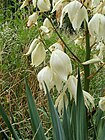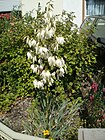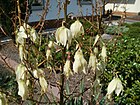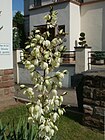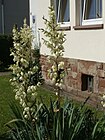Note: This is a project under development. The articles on this wiki are just being initiated and broadly incomplete. You can Help creating new pages.
Difference between revisions of "Yucca gloriosa"
(Created page with "{{stub}} ==Uses== {{Uses|}}, {{Uses|}}, {{Uses|}}, {{Uses|}}, {{Uses|}}, {{Uses|}}, {{Uses|}}, {{Uses|}}, {{Uses|}}, {{Uses|}}, {{Uses|}}. ==Parts Used== {{Parts Used|}}, {{...") |
|||
| Line 1: | Line 1: | ||
| − | + | '''Yucca gloriosa''' is an evergreen shrubby plant growing 2.5 metres or more tall. The stems can be unbranched or, more commonly, branched, each plant eventually producing a clump of stems. | |
| − | |||
==Uses== | ==Uses== | ||
{{Uses|}}, {{Uses|}}, {{Uses|}}, {{Uses|}}, {{Uses|}}, {{Uses|}}, {{Uses|}}, {{Uses|}}, {{Uses|}}, {{Uses|}}, {{Uses|}}. | {{Uses|}}, {{Uses|}}, {{Uses|}}, {{Uses|}}, {{Uses|}}, {{Uses|}}, {{Uses|}}, {{Uses|}}, {{Uses|}}, {{Uses|}}, {{Uses|}}. | ||
==Parts Used== | ==Parts Used== | ||
| − | {{Parts Used|}}, {{Parts Used| | + | {{Parts Used|Fruits}}, {{Parts Used|Flowers}}, {{Parts Used|Flowering stem}}, {{Parts Used|Roots}}. |
==Chemical Composition== | ==Chemical Composition== | ||
| − | <ref name="chemical composition"/> | + | It contains Eight new spiro- and furostanol glycosides that were tigogenin derivatives were isolated from pericarp of Yucca gloriosa fruit etc.<ref name="chemical composition"/> |
==Common names== | ==Common names== | ||
| Line 17: | Line 16: | ||
===Dravya=== | ===Dravya=== | ||
===Rasa=== | ===Rasa=== | ||
| − | |||
===Guna=== | ===Guna=== | ||
| Line 30: | Line 28: | ||
==Habit== | ==Habit== | ||
| − | {{Habit|}} | + | {{Habit|Evergreen shrub}} |
==Identification== | ==Identification== | ||
| Line 49: | Line 47: | ||
==Mode of Propagation== | ==Mode of Propagation== | ||
| − | {{Propagation|}} | + | {{Propagation|Seeds}}, {{Propagation|Root cuttings}}. |
==How to plant/cultivate== | ==How to plant/cultivate== | ||
| − | <ref name="How to plant/cultivate"/> | + | Yucca gloriosa is a plant of the warm temperate to subtropical zones of southeastern N. America, though it is also often cultivated in the tropics, where it can succeed down to sea level.<ref name="How to plant/cultivate"/> |
==Commonly seen growing in areas== | ==Commonly seen growing in areas== | ||
| − | {{Commonly seen|}}, {{Commonly seen| | + | {{Commonly seen|Coastal dunes}}, {{Commonly seen|Sandy soils of coastal plains}}. |
==Photo Gallery== | ==Photo Gallery== | ||
<gallery class="left" caption="" widths="140px" heights="140px"> | <gallery class="left" caption="" widths="140px" heights="140px"> | ||
| + | 20110710Yucca gloriosa1.jpg | ||
| + | |||
| + | |||
| + | 20110710Yucca gloriosa2.jpg | ||
| + | |||
| + | |||
| + | 20110710Yucca gloriosa3.jpg | ||
| + | |||
| + | |||
| + | 20120626Yucca gloriosa1.jpg | ||
| + | |||
| + | |||
| + | 20120626Yucca gloriosa2.jpg | ||
| + | |||
| + | |||
| + | 20120626Yucca gloriosa3.jpg | ||
| + | |||
| + | |||
| + | 20120626Yucca gloriosa4.jpg | ||
| + | |||
| + | |||
| + | 20120626Yucca gloriosa5.jpg | ||
| + | |||
| + | |||
| + | 20120703Yucca gloriosa1.jpg | ||
| + | |||
| + | |||
| + | 20120703Yucca gloriosa2.jpg | ||
</gallery> | </gallery> | ||
| Line 65: | Line 91: | ||
<references> | <references> | ||
| − | <ref name="chemical composition">[ | + | <ref name="chemical composition">[https://www.researchgate.net/publication/274739901_Steroid_Composition_of_Fruit_from_Yucca_gloriosa_Introduced_into_Georgia Chemical constituents]</ref> |
| − | <ref name="Leaf">[ | + | <ref name="Leaf">[Morphology]</ref> |
| − | <ref name="How to plant/cultivate">[ | + | <ref name="How to plant/cultivate">[http://tropical.theferns.info/viewtropical.php?id=Yucca+gloriosa Cultivation]</ref> |
</references> | </references> | ||
Revision as of 16:46, 7 September 2020
Yucca gloriosa is an evergreen shrubby plant growing 2.5 metres or more tall. The stems can be unbranched or, more commonly, branched, each plant eventually producing a clump of stems.
Contents
- 1 Uses
- 2 Parts Used
- 3 Chemical Composition
- 4 Common names
- 5 Properties
- 6 Habit
- 7 Identification
- 8 List of Ayurvedic medicine in which the herb is used
- 9 Where to get the saplings
- 10 Mode of Propagation
- 11 How to plant/cultivate
- 12 Commonly seen growing in areas
- 13 Photo Gallery
- 14 References
- 15 External Links
Uses
[[:Category:Ayurvedic Herbs known to be helpful to treat |]], [[:Category:Ayurvedic Herbs known to be helpful to treat |]], [[:Category:Ayurvedic Herbs known to be helpful to treat |]], [[:Category:Ayurvedic Herbs known to be helpful to treat |]], [[:Category:Ayurvedic Herbs known to be helpful to treat |]], [[:Category:Ayurvedic Herbs known to be helpful to treat |]], [[:Category:Ayurvedic Herbs known to be helpful to treat |]], [[:Category:Ayurvedic Herbs known to be helpful to treat |]], [[:Category:Ayurvedic Herbs known to be helpful to treat |]], [[:Category:Ayurvedic Herbs known to be helpful to treat |]], [[:Category:Ayurvedic Herbs known to be helpful to treat |]].
Parts Used
Fruits, Flowers, Flowering stem, Roots.
Chemical Composition
It contains Eight new spiro- and furostanol glycosides that were tigogenin derivatives were isolated from pericarp of Yucca gloriosa fruit etc.[1]
Common names
| Language | Common name |
|---|---|
| Kannada | |
| Hindi | |
| Malayalam | |
| Tamil | |
| Telugu | |
| Marathi | |
| Gujarathi | |
| Punjabi | |
| Kashmiri | |
| Sanskrit | |
| English |
Properties
Reference: Dravya - Substance, Rasa - Taste, Guna - Qualities, Veerya - Potency, Vipaka - Post-digesion effect, Karma - Pharmacological activity, Prabhava - Therepeutics.
Dravya
Rasa
Guna
Veerya
Vipaka
Karma
Prabhava
Habit
Identification
Leaf
| Kind | Shape | Feature |
|---|---|---|
Flower
| Type | Size | Color and composition | Stamen | More information |
|---|---|---|---|---|
| {{{5}}} |
Fruit
| Type | Size | Mass | Appearance | Seeds | More information |
|---|---|---|---|---|---|
Other features
List of Ayurvedic medicine in which the herb is used
Where to get the saplings
Mode of Propagation
How to plant/cultivate
Yucca gloriosa is a plant of the warm temperate to subtropical zones of southeastern N. America, though it is also often cultivated in the tropics, where it can succeed down to sea level.[3]
Commonly seen growing in areas
Coastal dunes, Sandy soils of coastal plains.
Photo Gallery
References
- ↑ Chemical constituents
- ↑ [Morphology]
- ↑ Cultivation
External Links
- [ ]
- [ ]
- [ ]
- Ayurvedic Herbs known to be helpful to treat
- Herbs with Fruits used in medicine
- Herbs with Flowers used in medicine
- Herbs with Flowering stem used in medicine
- Herbs with Roots used in medicine
- Habit - Evergreen shrub
- Index of Plants which can be propagated by Seeds
- Index of Plants which can be propagated by Root cuttings
- Herbs that are commonly seen in the region of Coastal dunes
- Herbs that are commonly seen in the region of Sandy soils of coastal plains
- Herbs
